-
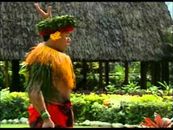
#IslandArchive - Polynesian Cultural Center in Hawaii
Check out this awesome demonstration from this Samoan master at the Polynesian Cultural Center! Using that classic faleaitu (Samoa comedy) style of delivery, Chief Sielu shows tourists the know how and can do of creating fire- Samoa Style!
-
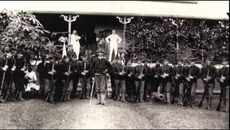
50th Samoan Independence - Part 1
Take a look at the history of Samoa and it's rocky road to Independence in this stunning documentary. In Part 1 of the series by Tagata Pasifika, they look at the history of the Samoa and it's people - from the German and US rule and division, to banishment of important leaders of the Mau Movement.
-
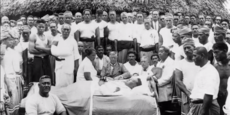
50th Samoan Independence - Part 2
Take a look at the history of Samoa and it's rocky road to Independence in this stunning documentary by Tagata Pasifika
-
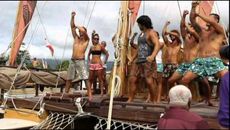
50th Samoan Independence - Part 3
Take a look at the history of Samoa and it's rocky road to Independence in this stunning documentary from Tagata Pasifika.
-
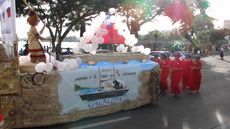
50th Samoan Independence - Part 4
Take a look at the history of Samoa and it's rocky road to Independence in this stunning documentary from Tagata Pasifika.
-
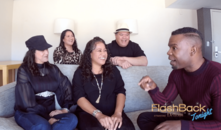
80's ICONS 'THE JETS'
Flashback Tonight goes on location to catch up with the hit making siblings from the 80's THE JETS. They let it all hang out regarding the family split, not being able to read music & songs they hate & miss singing. Also if you were around in the 90s you may remember RnB group 'All 4 One' - the Flashback Tonight interviewer is part of that group!
-
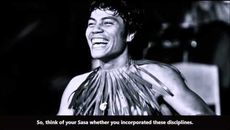
Aganu'u ma Measina a Samoa
During the Aganu'u ma Measina Festival 2013 held in Apia Samoa, Mata'afa Elia Autagavaia made an imprressive and informative speech. Mata'afa Elia Autagavaia takes us through the do's and dont's of how to participate in multiple traditional methods from performance to behaviour. In his speech he covers regulations and corrections around the Ma'ulu'ulu (Ladies dance), Sāsā (Rhythmic dance), Fa'ataupati (Male slap dance), even playing the part of the Fuataimi or how we should be singing a pese (song). Other cultural activities include dancing in the roles of Taupou, 'Aiuli, and most importantly, getting involved with Folafola Sua. Mata'afa Elia Autagavaia is a judge at these competitions. He is also a Samoan Teacher and a language and culture specialist at MESC
-
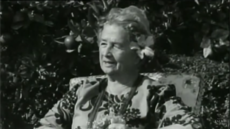
Aggie Greys
Take a look back at the iconic Aggie Greys hotel in Apia, as it launches as a Sheraton today! Aggie Grey, the original 'Bloody Mary' from the South Pacific movie of years ago, started a Pacific legacy in Samoa; and now her grandson is expanding that legacy into Tahiti.
-
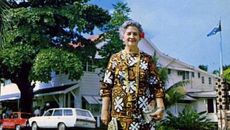
AGGIE GREYS HOTEL
The extraordinary story of Aggie Grey and the building of her hotel empire is one that has held the hearts of many who have had the opportunity to stay at the iconic property. {{5644}} Built on swamp land from a meager $200 loan from a family member, the hotel went through many famous transitions by an extraordinary woman who put her best foot forward in a male dominated business world and kicked the door open for years to come. {{5646}} This archival piece from Tagata Pasifika traces the families history before the opening of its second hotel in the early 2000s.
-
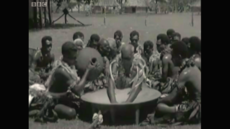
A Journey through the South Seas- Firewalkers of Fiji (1960)
Check out this awesome footage of acclaimed British broadcaster and naturalist David Attenborough as he visits Fiji - back in 1960! Taking a look back in time at the unique cultural practices of the brothers and sisters from the beautiful islands of Fiji!
-
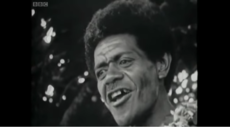
A Journey through the South Seas - Outer Islands of Fiji (1960)
Check out this awesome footage of acclaimed British broadcaster and naturalist David Attenborough as he visits the outer islands Fiji - back in 1960! Taking a look back in time at the unique cultural practices - including the unique calling of the Shark and Turtle on the island of Koro and Vanua Balavu fishing rituals! Source: BBC World
-
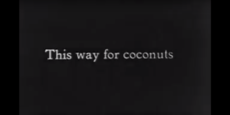
Amazing Footage of Life in Hawaii in the 1920's
Awesome silent video of Life in Hawaii in the 1920s! A fisherman with net casting through surf, catches mullet, fishing at night with spears and torches, Kalapana beach, black sand, boys play in surf, climb coconut trees, couple in modern bathing suits breaking coconuts, drinking coconut milk.
-
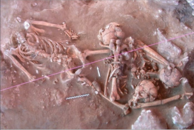
Ancient Skulls from Vanuatu shed light on Polynesian migration
Scientists studying skulls found at a 3,000-year-old cemetery in Vanuatu say they may have unlocked a vital clue to the origins of Polynesian people. Professor Matthew Spriggs, from the Australian National University's (ANU) school of archaeology and anthropology, is part of a team that in 2004 discovered the oldest known cemetery in the South Pacific, at Teouma, just outside the capital of Port Vila. The excavation took place over several years, between 2004 and 2010. But the team's painstaking work proved well worth their time. PHOTO Matthew Spriggs (far right) with most of the Teouma dig team in the 2006 season. SUPPLIED: MATTHEW SPRIGGS During the excavation they found about 68 graves, although curiously only seven heads. "The heads were removed as part of burial rituals and were taken away and put elsewhere," Professor Spriggs told 666 ABC Canberra. "But luckily for us, some of them were brought back in the cemetery and put on the chests of other bodies, or between their legs, or in pots sitting on top of other bodies." These seven heads turned out to be very significant, Professor Spriggs said. According to the professor and his colleagues, their discovery helps show that the Polynesians migrated from South-East Asia through Melanesia and into Polynesia, with little or no mixing in the early generations with the Melanesian populations of Papua New Guinea and the Solomons that had been in the region for the previous 50,000 or so years. Cemetery held first people of Vanuatu PHOTO Fidel Yoringmal, the project's artist who has since passed away, drawing a Teouma skeleton. SUPPLIED: MATTHEW SPRIGGS Professor Spriggs said the cemetery was proved be about 3,000 years old and related to the first known culture in Vanuatu and Polynesia, called the Lapita culture. "Before 3,000 years ago - although people had been in Australia, New Guinea and the Solomons for maybe 50,000 years or so - they hadn't got out beyond into islands like Vanuatu, Fiji, New Caledonia, and out into the further reaches of the Pacific," he said. "So this was exciting, because it was the first generations of people into Vanuatu." In a paper co-authored with other researchers from ANU and the French National Centre for Scientific Research, Professor Spriggs explained that the origin of Polynesian people had puzzled scientists since the first explorers' voyages of the 16th century. "You've got this problem," he said. "You've got South-East Asia and then you've got Melanesia in the middle with darker skinned people of different appearance, and then you've got Polynesians in the east." It has long been established that the Polynesians, who share similar physical features to people from South-East Asia, migrated from Asia. What is not clear is the route they took. "You have to get Polynesians out of Asia somehow," Professor Spriggs said. "You've got some people who have them going up through the north and coming down through north America, and then coming that way, from the Americas. PHOTO Teouma in Vanuatu from the air - the cemetery dig site is under the tent to the bottom left. SUPPLIED: STUART BEDFORD "Others had them coming by various routes, either from the north through Micronesia or perhaps coming later or earlier. "What we're able to show is that in fact, for places like Vanuatu and New Caledonia and Fiji, they do arrive before there's anybody else here." Professor Spriggs said the other major research finding was that not long after the arrival of the Polynesians in places like Vanuatu, Melanesians from further west began to arrive. "People in the New Guinea and Solomons area also jumping on these Lapita canoes and getting excited by the culture and travelling to new parts," he said. "Over time, and this is just over the first couple of hundreds of years in Vanuatu, the appearance of people changes from looking like Polynesians people look today, to looking like Melanesian people today." Skulls help prove migration via Melanesia As part their research, Professor Spriggs' colleagues in Europe compared the seven skulls found in the Teouma cemetery with examples of skeletons from Melanesia and Polynesia. PHOTO Experts Fidel Yoringmal and Frederique Valentin at the Teouma cemetery dig in Vanuatu. SUPPLIED: MATTHEW SPRIGGS "We work with specialist biological anthropologists ... they're the ones who've been doing all the measurement on what skulls we do have to compare ... in a forensic way, with modern populations today," he said. "What we found, which was a surprise for a lot of people, was that these first people in Vanuatu were Polynesian. Whereas today if you come to Vanuatu, the people are obviously generally of Melanesian appearance. Darker skinned, and not as tall as Polynesians would be. These [the people buried in cemetery] were very tall Polynesians." The skulls found at Teouma were similar in appearance and measurements to present day Polynesian and Asian populations. Professor Spriggs said this provided evidence that Polynesia was populated by people who came from Asia via Vanuatu. The next step is to examine DNA from the Teouma skeletons. "We're really working very hard on this at the moment ... we think we can. We're working on it with a team from Europe," Professor Spriggs said. He said DNA analysis could help confirm or discount the team's conclusions about the Teouma skeletons. "Or it could even narrow it down to where in South-East Asia these ancestors of the Polynesians, and these ancestors of the people in Vanuatu came from," he said. Source: ABC News
-
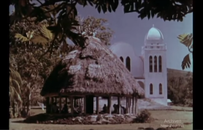
A New Day in Samoa
Take a step back in time with this documentary from 1959 from Archives New Zealand, about life in Samoa!
-
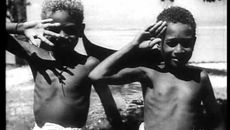
Army and Airforce - Daily life in the Solomon Islands 1943
Check out this throw back of NZ soldiers as they go about their day-to-day lives in the Solomon Islands!
-
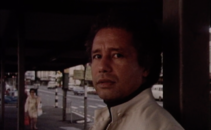
Auckland Fa'a Samoa: A Story of Samoans in the City 1982
{{11443}} Life in Auckland for Pacific Islanders in the 1980s was hugely different from today, take a look back at the era of a brown inner city, late night shopping KRoad, and tail end of the infamous dawn raids.
-
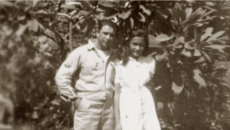
BORN OF CONFLICT - Children of the Pacific War
Between 1942 and 1945, more than 2 million Americans went to war in the South Pacific. When World War II ended they went home leaving 100,000 dead, tons of military equipment and over 2,000 children. This doco looks at the stories of three children left behind by American servicemen posted to the Pacific during WWII. Now in their early 70s, these children were identified through an Otago University research programme.
-
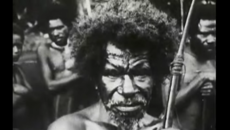
Cannibals of the South Seas (1920)
Check out this amazing archive footage of the Tomman Island - showing life on the small island in Vanuatu! Customs of the inhabitants of Tomman Island in the 1920s, probably extracted from Martin Johnson's film Among The Cannibal Isles of the South Pacific (1918) - including the practice of head binding thought to make the brain 'go further'
-
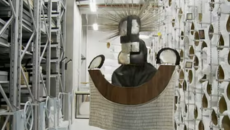
Chief mourner's costume from the Society Islands
Check out the intricate ceremonial costume worn by the Chief Mourner in the Society Islands, held at Te Papa in Wellington! In the Pacific it wasn't always appropriate to wear black to a funeral. Several hundred years ago the fashion was a frightening outfit made from precious pearl and black shell.
-
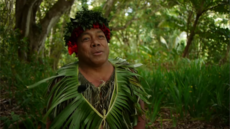
Chief Sielu Avea, Ambassador of Polynesia
Hawai'i is a true melting pot, and you meet people from all over the world here. But few have a biography as colorful, diverse and remarkable as the subject of this story. Meet Chief Sielu Avea, an "Ambassador of Polynesia" who shares the culture and traditions of his home at venues throughout O'ahu.
-
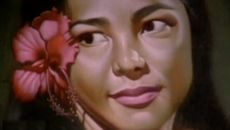
Cook Islands Princess
These are only some of the artwork & drawings by Mama Tupou at the tender age of 74 yrs. Mama Tupou has had several Art exhibits including Tivaevae bedspreads. Her late Mother, Mama Toa was an expert Taunga in Tivaevae Art. Mama Tupou is the iconic N.Z Dusky Maiden, immortalised on black velvet by the late, Charlie Mcphee. Hailed as a goddess she is without doubt one of the most beautiful Polynesian women ever painted in history.
-
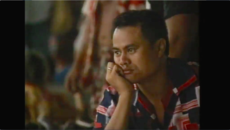
Cyclone Ofa
Take a step back in time - all the way back to 1990 when Tropical Cyclone Ofa devasted the Pacific. Ofa first hit Tuvalu before moving on to Western Samoa and American Samoa, Tokelau, Niue and Tonga. The worst effects were recorded in Samoa, where seven people were killed. Roughly 200 people were evacuated, and 10 to 20 others were injured through the islands.
-
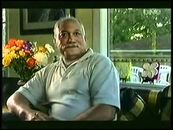
Dawn Raids
In the early 1960's, New Zealand was considered to be the land of 'Milk and Honey' for many Pacific families looking to work and make money for their families back in their homelands. But unfortunately after the New Zealand economy took a nosedive, Pacific people found themselves arrested and deported back to their islands by the truckload. Check out this documentary on one of the darkest days of New Zealand history.
-
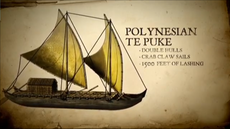
Did Polynesians Discover America?
Who were the first people to discover America? Historical evidence uncovers the myth of Christopher Columbus being the first to America. Check out some of the clues that show Polynesians visited the shores of America long before it was discovered by Europeans! Check out more information here!
-
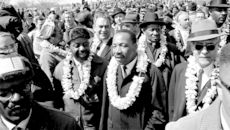
Dr. Martin Luther King and the lei connection
Why did the Rev. Martin Luther King Jr. wear a lei on his famous 1965 march from Selma to Montgomery, his relationship with Akaka and other Hawaii ties of the great civil rights leader. Ever wonder why the Rev. Martin Luther King Jr. and other civil rights leaders on that famous march from Selma to Montgomery, Ala. wore lei? Turns out King had special ties to the Aloha State, and to the family of U.S. Sen. Daniel Akaka, D-Hawaii. It's altogether fitting that the Hawaii Legislature opens its annual session this week as the state and the rest of the nation commemorate what would have been King's 83rd birthday. King, in his 1959 address to a special session of the Hawaii Legislature, praised Hawaii for its ethnic diversity. "We look to you for inspiration and as a noble example, where you have already accomplished in the area of racial harmony and racial justice, what we are struggling to accomplish in other sections of the country, and you can never know what it means to those of us caught for the moment in the tragic and often dark midnight of man’s inhumanity to man, to come to a place where we see the glowing daybreak of freedom and dignity and racial justice," King said in his address. Five years after those words, King carried a bit of Hawaii to Alabama. That five-day, 54-mile march from Selma, where an Alabama state trooper had shot and killed church deacon Jimmie Lee Jackson, to the state capital, helped bring King to the forefront of the nation's imagination, spurring the cause of nonviolent protest that would be picked up and championed by an entire generation, fomenting the hope of equality for all mankind. The lei were no artifice. King had strong Hawaii ties, from his 1959 address to the Hawaii Legislature to his relationship with the Rev. Abraham Kahikina Akaka, older brother of Sen. Daniel Akaka, D-Hawaii. Abraham Akaka, kahu (shepherd) of Kawaiahao Church in Honolulu, developed a close friendship with King when King came to Honolulu in 1964 to participate in a Civil Rights Week symposium at the University of Hawaii, according to Akaka's obituary in the Honolulu Star-Bulletin. Abraham Akaka later sent the lei to King as a gift, according to a 1991 article in Jet Magazine by Simeon Booker. Here's the text of King's speech, as recorded in the Journal of the Hawaii House of Representatives: The following remarks were made by Dr. Martin Luther King, Jr. on Thursday, September 17, 1959 at the Hawaii House of Representatives 1959 First Special Session: “Mr. Speaker, distinguished members of the House of Representatives of this great new state in our Union, ladies and gentlemen: It is certainly a delightful privilege and pleasure for me to have this great opportunity and, I shall say, it is a great honor to come before you today and to have the privilege of saying just a few words to you about some of the pressing problems confronting our nation and our world. I come to you with a great deal of appreciation and great feeling of appreciation, I should say, for what has been accomplished in this beautiful setting and in this beautiful state of our Union. As I think of the struggle that we are engaged in in the South land, we look to you for inspiration and as a noble example, where you have already accomplished in the area of racial harmony and racial justice, what we are struggling to accomplish in other sections of the country, and you can never know what it means to those of us caught for the moment in the tragic and often dark midnight of man’s inhumanity to man, to come to a place where we see the glowing daybreak of freedom and dignity and racial justice. People ask me from time to time as I travel across the country and over the world whether there has been any real progress in the area of race relations, and I always answer it by saying that there are three basic attitudes that one can take toward the question of progress in the area of race relations. One can take the attitude of extreme optimism. The extreme optimist would contend that we have come a long, long way in the area of race relations, and he would point proudly to the strides that have been made in the area of civil rights in the last few decades. And, from this, he would conclude that the problem is just about solved now and that we can sit down comfortably by the wayside and wait on the coming of the inevitable. And then segregation is still with us. Although we have seen the walls gradually crumble, it is still with us. I imply that figuratively speaking, that Old Man Segregation is on his death bed, but you know history has proven that social systems have a great last-minute breathing power, and the guardians of the status quo are always on hand with their oxygen tents to keep the old order alive, and this is exactly what we see today. So segregation is still with us. We are confronted in the South in its glaring and conspicuous forms, and we are confronted in almost every other section of the nation in its hidden and subtle forms. But if democracy is to live, segregation must die. Segregation is a cancer in the body politic which must be removed before our democratic health can be realized. In a real sense, the shape of the world today does not permit us the luxury of an anemic democracy. If we are to survive, if we are to stand as a force in the world, if we are to maintain our prestige, we must solve this problem because people are looking over to America. Just two years ago I traveled all over Africa and talked with leaders from that great continent. One of the things they said to me was this: No amount of extensive handouts and beautiful words would be substitutes for treating our brothers in the United States as first-class citizens and human beings. This came to me from mouth of Prime Minister Nkrumah of Ghana. Just four months ago, I traveled throughout India and the Middle East and talked with many of the people and leaders of that great country and other people in the Middle East, and these are the things they talked about: That we must solve this problem if we are to stand and to maintain our prestige. And I can remember very vividly meeting people all over Europe and in the Middle East and in the Far East, and even though many of them could not speak English, they knew how to say ‘Little Rock.’ And these are the things that we must be concerned about – we must be concerned about because we love America and we are out to free not only the Negro. This is not our struggle today to free 17,000,000 Negroes. It’s bigger than that. We are seeking to free the soul of America. Segregation debilitates the white man as well as the Negro. We are to free all men, all races and all groups. This is our responsibility and this is our challenge, and we look to this great new state in our Union as the example and as the inspiration. As we move on in this realm, let us move on with the faith that this problem can be solved, and that it will be solved, believing firmly that all reality hinges on moral foundations, and we are struggling for what is right, and we are destined to win. We have come a long, long way. We have a long, long way to go. I close, if you will permit me, by quoting the words of an old Negro slave preacher. He didn’t quite have his grammar right, but he uttered some words in the form of a prayer with great symbolic profundity and these are the works he said: ‘Lord, we ain’t what we want to be; we ain’t what we ought to be; we ain’t what we gonna be, but thank God, we ain’t what we was.’ Thank you.” At the conclusion of his address, there was much applause. Source: All Hawaii News
-
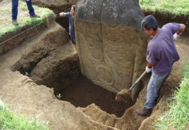
Easter Island secrets uncovered
A new series of photographs from a 2012 excavation on Easter Island (Rapanui) have emerged showing previously hidden bodies and intricate patterns adorning the Moai statues. The images have been shared far and wide on social media, being viewed more than 1 million times on Imgur. They show detailed markings such as crescents, which academics say represent the canoes of the early Polynesians who had settled on the island, the UK’s Mirror reports. There are 887 huge statues carved between AD 100 and 1800, most of which are up to 10 metres tall. The Easter Island Statue Project have been excavating the statues for years, and provided the first photos of their torsos in 2012. “The reason people think they are (only) heads is there are about 150 statues buried up to the shoulders on the slope of a volcano, and these are the most famous, most beautiful and most photographed of all the Easter Island statues,” Jo Anne Van Tilburg from the Easter Island Statue Project said. The first pictures of the statues showing their full size were taken in 1919 by the Mana Expedition - this was later confirmed by the explorer Thor Heyerdahl and his Norwegian Archeological Expedition in 1955. This confirms previous claims that the island was first settled by Polynesian people as part of the great wave of Pacific colonisation. Still, not much is known about the true origins of the statues and how they were made - but this new find puts us one step closer to finding the truth about it's inhabitants and the beautiful stone monoliths they left behind.
-
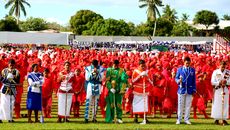
Education Day in Tonga
Thousands of students performed for the King and Queen at a colourful Education Day at Teufaiva Outdoor Stadium. The theme ‘Showcasing Education in Tonga’ was in honour of the Coronation of King Tupou VI and Queen Nanasipau’u. Students from Tonga’s Institute of Science and Technology, ‘Ahopanilolo Technical Institute and Monfort Technical Institute demonstrated their vocational skills in carpentry by building a house, and showing off hospitality and combat skills.
-
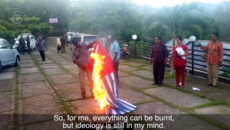
EVERYTHING CAN BE BURNT - West Papua in the Jokowi Era
The face of West Papuan society is changing but RNZ International found that the core ideology of the indigenous people of Indonesia's Papua region is not easily destroyed. Since the making of this documentary, a petition signed by 1.8 million West Papuans seeking an independent vote and self determination was rejected by the United Nations. The United Liberation Movement for West Papua now hopes New Zealand's new Prime Minister Jacinda Ardern will take up the issue of their Self Determination with many of her Pacific leaders in the Labour government very supportive of West Papua's human rights.
-
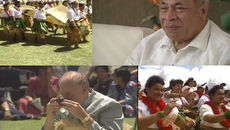
FAKAPANGAI: In the Circle of the Sovereign
In 1993, His Majesty King Taufa'ahau Tupou IV of the Kingdom of Tonga ventured to Hawaii to bestow a traditional title; Mafifakapotu. This was the first and only time His Majesty has allowed this ceremony to be held outside the confines of his island kingdom in the South Pacific. Join with the celebrants in witnessing this amazing investiture filled with ancient tradition and historic significance.
-
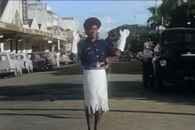
Fiji Flashback: Unearthed footage shows Suva in the 1960s
By 1960 Suva was the biggest city in the South Pacific, and the ABC was there to document life in the then British colony. The ABC’s Weekend Magazine filmed on the streets of Suva, showcasing life in Fiji’s capital. To see more of the ABC Pacific collection head to the ABC Pacific Collection
-
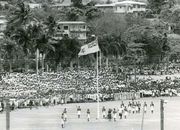
FIJI INDEPENDENCE
Fiji became an independent sovereign state on 10th October 1970 when its colonial status was abrogated. Ratu Sir Kamisese Mara, the first Prime Minister of independent Fiji, received from Prince Charles the documents evidencing Fiji’s independence. That independence was and remains a great source of pride and joy to all Fiji citizens. On that day the dark clouds of colonialism were swept away. This 5 part documentary looks at the road to Fiji's independence. . Part 2 {{5666}} Part 3 {{5667}} Part 4 {{5668}} Part 5 {{5669}}
-
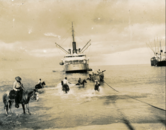
Hawaiian Cowboys - The Little Known History of Paniolo
Picture Hawaii. What do you see? Surf, sun, sand and... Cowboys? It might be hard to believe, but the history of cattle ranching and Paniolo (Hawaiian cowboys) stretches back centuries. It could be argued the cattle that graze the rolling and lush patures of northerly Waimea, are among the happiest in the world. With sea views and food in plentiful supply, it's easy to see why. But in 1793 it was on an entirely different landscape. Across rough lava and up the hot and steep arid mountain trails of south Kona is where the beasts first made a rough and tumble debut. Navigator George Vancouver landed the Kingdom of Hawaii’s first cows in Kealakekua, a gift to King Kamehameha I in 1793. As more arrived and those creatures multiplied, they ignited an industry that came decades before the great cattle ranching boom of the American West. Kona’s piece of that history is now the focus of an exhibit in the Smithsonian-affiliated Kona Historical Society’s H.N. Greenwell General Store Museum. The installment of original artifacts, photos, diary entries and tax ledgers will be on show until July 30. “Kona’s story is a little known one,” says Joy Holland, executive director of KHS, “but it’s an important one nonetheless.” Some of the items on show include black and white photos depicting cows—herded by horses and paniolo of Hawaiian, Chinese and Japanese ancestry—swimming in the sea to the ships that would take them to Honolulu and beyond before area docks were installed. Physical artifacts are also on display, such as branding irons from the different ranching families that made a living in Kona after an early kapu (prohibition) on taking cattle was lifted. A set of massive long horns suggests that Hawaii’s cattle perhaps weren’t the same mild mannered mooers of present day. Mina Elison, Kona Historical Society’s curator and great granddaughter of famous Hawaiian-Chinese paniolo Willie Thompson, explained the significance of one of the treasures: A map showing the location of the Pa Nui, the Great Walled Lot. This rock wall enclosure once stretched 480 acres with walls reaching eight feet; it was an engineering feat for the time and Hawaii’s first cattle corral. Playing the important role of keeping the cattle contained. Prior to the corral’s construction, Archibald Menzies, a ship’s surgeon wrote this in his 1793 journal: “When they [cattle] landed they ran up and down the country in the wildest manner to the [sic] no small dread and terror of the natives, who fled from them with the utmost speed in every direction.” As time and nature eroded the Great Walled Lot, some of the massive beasts broke free, colonizing the entire Island and terrorizing Kona residents until the later Kuakini Wall was built to protect homes from the free ranging cows. In the 1830s, vaqueros (cowboy ranchers) from what is today the Monterey, California area were brought in to teach Kona residents how to wrangle their wild terrors into an industry. The exhibit lines the walls of the permanent antique shop displays within the historic H.N. Greenwell Store. The store is a holding of the Kona Historical Society. “We are mindful that we are sharing the history of families that come from this community,” says Holland. “And, we hope to give visitors a clear-eyed view of what Hawaii is about by offering exhibits like this one.” Source: Hawai'i Magazine
-
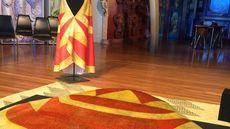
Historic Hawaiian Cloak & Helmet returned to rightful owners
After 237 years travelling the world, Kalani‘ōpu‘u’s ‘ahuʻula (feathered cloak) and mahiole (feathered helmet) finally made their way back to Hawai'i in 2016. In 1779, Kalaniʻōpuʻu, aliʻi nui of Hawaiʻi Island, greeted Capt. James Cook in Kealakekua Bay and draped his treasured ʻahu ʻula over the newcomer’s shoulders as a gesture of goodwill. He also gave a number of other cloaks and a feather helmet. But these happy beginnings soon turned sour when Cook's men killed one of Kalani'opu'u's people. Captain Cook was killed in retaliation. Kalaniʻōpuʻu’s feathered cape and mahiole sailed back to Europe with Cook’s crew, and ultimately ended up at the National Museum of New Zealand Te Papa Tongarewa. An unprecedented partnership between the Office of Hawaiian Affairs, Bishop Museum and Te Papa with support from Hawaiian Airlines enabled the return of Kalaniʻōpuʻu’s priceless garments. In March 2016, a delegation from the Office of Hawaiian Affairs, Bishop Museum and Hawaiian Airlines traveled to Aotearoa to engage in protocol and return the ʻahuʻula and mahiole to Hawaiʻi. The Office of Hawaiian Affairs documented this awe-inspiring journey in the film, “Nā Hulu Lehua: The Royal Cloak and Helmet of Kalaniʻōpuʻu.” (Shown above) The 25-minute documentary shares the significance of high chief Kalaniʻōpuʻu, his mea kapu and the incredible partnerships that made their historic return home possible. Here are 5 things you need to know about these historic artifacts 1. According to expert scholar Adrienne Kaeppler’s publication Hawaiian Featherwork (2010), Kalani‘ōpu‘u’s cloak seemed to have started as a cape. The design has two red triangles (huinakolu) at the neckline and a red crescent (hoaka) which formed a sacred, protective design; the resulting yellow triangles and a yellow strip at the bottom complete the original cape. The use of so many yellow feathers demonstrates the political power of Kalani‘ōpu‘u. 2. This ‘ahu ‘ula in particular has feathers from about 20,000 birds. Skilled trappers caught the birds by employing various techniques such as snaring their prey midair with nets, or using decoy birds to lure them onto branches coated with a sticky substance. They often harvested only a few feathers from each bird before releasing them back into the wild so they could produce more feathers. Skilled workers belonging to the aliʻi class crafted the olonā cordage backing, a netting used as the foundation for the cloak, onto which the bundles of feathers were attached, creating bold designs. 3. The cloak has traveled to Hawai‘i twice without the mahiole: Mayday in 1960 and during the exhibition celebrating the 100 Anniversary of Captain Cook and his artificial Curiosities, Jan 18 through July 31, 1978. However, this was the first time in 237 years that both the cloak and helmet went back home to Hawai'i together. 4. From a historical perspective, the artifacts represent a period in the timeline of Hawai‘i when there was a balance between the cultural, political and spiritual parts of Native Hawaiians and the environment. 5. The exhibit space at Bernice Pauahi Bishop Museum where it now lives is called ‘He Nae Ākea: Bound Together.’ This reflects the connection of Kalani‘ōpu‘u to his land and people, the connection between the peoples, nations, and cultures throughout the centuries who have cared for these treasures, as well as the connection between the three institutions directly involved in this loan.
-
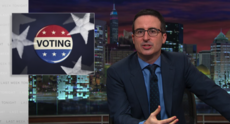
History behind why some U.S territories can't vote
In Guam and American Samoa, you can serve in the U.S. military but can't vote. Here's why... A set of Supreme Court decisions made over 100 years ago has left U.S. territories without meaningful representation. Think that's fair?
-
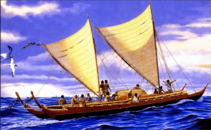
How Ancient Humans Reached Remote South Pacific Islands
Some 3,400 years ago, before the Iron Age or the rise of Ancient Greece, people on the Solomon Islands left their white sandy shores for the cerulean seas of the South Pacific. Their adventures brought humanity to the most remote reaches of Oceania, like the tropical islands of Hawaii, Tonga and Fiji. “The first ones were traveling into the unknown,” said Alvaro Montenegro, a geographer and climatologist from Ohio State University. “They would leave the coast, and it would disappear behind them.” Archaeological evidence suggests that after setting sail from the Solomon Islands, people crossed more than 2,000 miles of open ocean to colonize islands like Tonga and Samoa. But after 300 years of island hopping, they halted their expansion for 2,000 years more before continuing — a period known as the Long Pause that represents an intriguing puzzle for researchers of the cultures of the South Pacific. “Why is it that the people stopped for 2,000 years?” said Dr. Montenegro. “Clearly they were interested and capable. Why did they stop after having great success for a great time?” To answer these questions, Dr. Montenegro and his colleagues ran numerous voyage simulations and concluded that the Long Pause that delayed humans from reaching Hawaii, Tahiti and New Zealand occurred because the early explorers were unable to sail through the strong winds that surround Tonga and Samoa. They reported their results last week in the journal of the Proceedings of the National Academy of Sciences. “Our paper supports the idea that what people needed was boating technology or navigation technology that would allow them to move efficiently against the wind,” Dr. Montenegro said. Once they found a way to conquer the wind, the ancient people ended their 2,000-year hiatus, and over a period of a few hundred years colonized the rest of Oceania, such as the islands of Hawaii, Tahiti and New Zealand. Via the New York Times - read the full article here
-
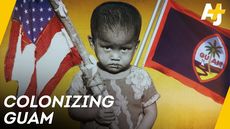
How the US Territory of Guam became an American Colony
The U.S. territory of Guam has a unique history as one of the longest-running colonies in history. How did it get this way? Guam has been colonized by the Spanish, occupied by the Japanese and militarized by the Americans. But the history of its indigenous Chamorro people goes back even further. AJ+ went to Guam to speak with indigenous Chamorro people about the island's complicated past. Watch the rest of the documentary series below: - Part 2 More Americans from Guam serve in the U.S. military, per capita, than from any U.S. state. But they can’t even vote for president. AJ+ Producer Jun Stinson goes to Guam to speak with service members and veterans about what it's like to serve a country that doesn't allow you to vote. Then she meets up with indigenous Chamorro activists who are fed up and consider Guam to be a U.S. colony. {{15258}} . Part 3 There’s a growing movement of young people on Guam who envision a sustainable future for the island. They want to end the island's dependency on imported processed foods, which has been ongoing since World War II and has led to high rates of heart disease and diabetes. {{15259}} . Part 4 What does it mean to be a citizen of a United States territory and also be indigenous? The Chamorro people on Guam tell us about their multifaceted — and often complicated — identity. {{15260}}
-
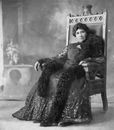
Incredible Hawaiian Women in History
These influential wāhine and their achievements in Hawaii's history paved the way for all Hawaiian women, as well as women around the Pacific! Source: Hawaii Magazine 1. Queen Emma Photo: Wikipedia In 1859, Queen Emma Kalanikaumakaʻamano Kaleleonālani Naʻea Rooke established Queen's Hospital to save the rapidly declining Native Hawaiian population, providing free services to those suffering from foreign-introduced illnesses like smallpox and influenza. In 1867, she founded The St. Andrew’s Priory School for Girls. Her talents extended into music as a vocalist, pianist and dancer and regarded for her skills as an equestrian. 2. Kaʻahumanu Photo: Wikipedia Kaʻahumanu, arguably the most influential woman in the course of Hawaiian history, was considered to be the most powerful woman in Hawaiian society as Kamehameha’s trusted adviser. She wielded her political power as his favorite wife and the kingdom's first kuhina nui (similar to a prime minister) to campaign for the rights of Native Hawaiian women. Under her counsel she staged a turning point in Hawaiian society: convincing the young King Kamehameha II to publicly eat at the same table with women (a major taboo), which in turn abolished the ancient kapu system that prohibited women from engaging in the same activities once only reserved for men. 3. Isabella Aiona Abbott Photo: University of Hawaii An ethnobotanist from Hāna on Maui, Isabella Kauakea Yau Yung Aiona Abbott became the first Native Hawaiian woman to receive a PhD in science. Of mixed Chinese and Hawaiian ancestry, Abbott learned about limu (Hawaiian algae) from her Hawaiian mother, setting the foundation for what would make her the leading expert on Pacific algae according to the academic record. She’s credited for discovering over 200 species, including a family of the Rhodomelaceae (red algae) family, a genus of which is named Abbottella, after her work in the field. In her career she wrote eight books, applying her native knowledge to author one on marine algae of California’s Monterey Peninsula, and more than 150 publications. 4. Rell Sunn Photo: Encyclopedia of Surfing/Jim Russi Known as the Queen of Mākaha, Rell Kapoliokaʻehukai Sunn was a world surfing champion and pioneer for women in the sport. With her cool and composed riding style, she shaped unity in the surf community by establishing a pro women's competitive surfing circuit for her peers and future generations. In 1975, she became Hawaiiʻs first female lifeguard presiding over her favorite beach on the North Shore. Sunn, affectionately called Aunty Rell, is also remembered for her long courageous battle with breast cancer. She was diagnosed in 1983 and given only a year to live. She overcame that prognosis by 15 years. She surfed every single day. 5. Patsy T. Mink Photo: U.S. Congress The first woman of color and the first Asian American elected to Congress, Patsy Takemoto Mink was a trailblazer in both local and national U.S. politics. With an impassioned nationally-televised speech she gave at the 1960 Democratic National Convention to 10,000 people, Mink is credited for persuading two-thirds of the Democratic party to continue their progressive stance on Civil Rights Issue, notably opposing motions to delete provisions such as a deadline to desegregate schools by 1963 and to make the Civil Rights Commission a permanent agency from the party's official platform. She also authored Title IX, a law which bans gender discrimination among federally-funded education programs.. In 1972, she also became the first Asian American woman to seek the presidential nomination of the Democratic Party. 6. Brook Lee Photo: Miss Universe Pageant Brook Mahealani Lee is the first Hawaiian, indigenous person and Asian American to win the Miss Universe crown. Her final competition answer during the Q&A portion is remembered for being one of the most memorable in beauty pageant history, responding that if she could do anything for a day without being confined to rules: “I would eat everything in the world.” 7. Aloha Dalire Dalire Kaneohe, known as Aloha Dalire, was named the first Miss Aloha Hula, then known as Miss Hula, at the inaugural Merrie Monarch Festival in 1971. The title is considered hula’s top solo wahine honor; each year at the festival held in Hilo, the best female hula dancers in the world compete for the prestigious award which crowns one as the most distinguished in the art form and cultural practice. She went on to become a prominent kumu hula (hula teacher). Her halau, Keolalaulani Halau ‘Olapa O Laka, competed at Merrie Monarch under her direct teachings for more than 40 years. Dalire was always a cause of excitement for the festival, many watching in anticipation to see what she’d bring to the kahiko(traditional) and ʻauna (modern) dance categories. She passed away at 64 in 2014, but her legacy lives on through her aloha spirit and lessons. 8. Michelle Wie Photo: Michelle Wie From Honolulu, Michelle Wie is the youngest winner of the U.S. Women’s Amateur Public LInks and the youngest to qualify for a LPGA Tour event. She turned a professional player at just 16 years old winning many high-profile and national endorsements. In 2014, she won her first major at the U.S. Women’s Open. 9. Jean King Photo: Mari Matsuda/Twitter Jean Sadako King was the first woman elected to be lieutenant governor of Hawaii from 1978 to 1982. She was considered a true pioneer for her achievements and as an advocate for affordable housing and the environment, particularly preserving Hawaii’s natural resources with the State Sunshine Law and the Shoreline Protection Act. She inspired many young women aspiring to work in politics with her public service. 10. Bernice Pauahi Bishop Photo: Kamehameha Schools Archives Princess Pauahi is one of Hawaii’s most important philanthropists. As an aliʻi(royal)—the last descendant of the Kamehameha line—she held the largest private landownership in the Islands, owning approximately 9% of Hawaii’s total acreage across the island chain. During her lifetime she saw the Native Hawaiian population dwindle from 124,000 to 44,000. Concerned for her people she focused her entire estate towards education. In 1887, as designated by her will, she established the Kamehameha Schools to bring educational opportunities to preserve, improve and perpetuate the well-being of future generations of Native Hawaiians, academically and culturally. Today her estate is worth about $11 billion. 11. Natasha Kanani Janine Kai Source: Instagram From Kahuku, Oahu, this professional soccer forward is also an Olympic gold medalist with a record-setting career. In the Western Athletic Conference (WAC), Kai became the first soccer player to be named both Freshman and Player of the Year in the same season. With 446 career shots, she also holds that career record and is second in goals (72) and points (162). Kai is also a role model for the LGBT community as an open lesbian in the sport (one of only three openly gay members on the 2008 USA Olympic Team). 12. Mazie Hirono Photo: U.S. Congress In 2013, Mazie Hirono became the first woman senator from Hawaii and the first Asian-American woman in the U.S. Senate, and currently the only person of Asian ancestry in the Senate currently. She’s the nation’s first Buddhist elected also. When she first immigrated with her family to Hawaii from Japan at the age of 7, she couldn’t read or speak English, and today serves on many committees championing women’s reproductive rights. 13. Alice Ball Photo: Wikipedia Born in Seattle in 1892, Alice Augusta Ball became both the first African-American and the first woman to graduate with a Master of Science degree in chemistry from the University of Hawaii in 1915. That year, she also became the first woman to teach chemistry at the school. In her research project at UH, Ball developed what was the most effective method of treatment for those suffering from Hansen’s Disease (leprosy) at the time. Her research was used as the basis for treating many patients at Kalaupapa, the community and colony on Molokai where those afflicted with the disease were quarantined. At just 24 years old, Ball suddenly passed away. While officially unknown, researchers suggest Ball’s tireless efforts investigating the properties of chaulmoogra oil to produce the treatment became a cause of exhaustion and could’ve attributed to her death. 14. Queen Liliʻuokalani Photo: Hawaii State Archives Liliʻuokalani was the last reigning monarch of the Kingdom of Hawaii. Upon taking the throne she wrote a new constitution that would restore veto power to the monarchy and enable economically disenfranchised Native Hawaiians and Asians to have voting rights and a voice in the political process. That constitution never became the law of the land as she was illegally overthrown by American and European businessman, supported by the U.S. military, who were threatened by these new governing views of the Queen. Imprisoned in her own palace, where she was locked away to its second-floor for nearly a year, Liliʻuokalani wrote her memoirs and composed mele (songs) such as “The Queen’s Prayer” and “Aloha ʻOe,” regarded famously today as a lament for the loss of Hawaiʻi nation. As a lone woman in the face this forceful removal from her rightful rule, she’s remembered for her resilience, belief in peaceful resistance and her attempts to re-empower the people of Hawaii over corporate interests. Throne-less, she continued to fight for the restoration of the Hawaiian Kingdom and revered by her people until her death in 1917. She was 79.
-
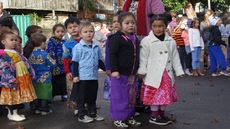
Island Archives: A'oga Fa'a Samoa
The A’oga Fa'a Samoa is an institution in Aotearoa and the Pacific, and has been instrumental in our bi lingual education in NZ. The award winning center has brought many generations of Samoan children through early childhood and had a huge impact on Samoan communities in Auckland. The A'oga Fa'a Samoa was established in 1984 and is based at Richmond Road Primary School in Central Auckland. It was established to help nuture the Samoan language and culture in young NZ-born Samoans by the community, for the community. Check out this vid from their 20th Anniversary DVD!
-
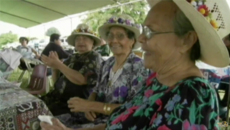
Island Archives - Olohega
Olohega. A small, idyllic Pacific island north of Samoa and just south of Tokelau. Bought for a bottle of gin and 15 shillings an acre. Annexed to the United States. Its former inhabitants were evicted in 1953 from their island and long to return. - Check out this article presenting a timeline of the United States claiming sovereignty over the Tokelau island of Olohega, most recently through a proclaimed “friendship treaty” organised by New Zealand. Curator Pacific Fuli Pereira has chosen this paper as a must read for Tokelau Language Week 2021
-
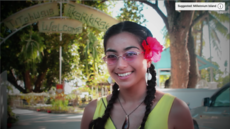
JULY 12TH - KIRIBATI INDEPENDENCE DAY
Lulu DeBoer spends her first Kiribati independence day in Kiribati and reflects on what independence means in the context of climate change. Also dancing dancing dancing, because everyone loves Kiribati dance.
